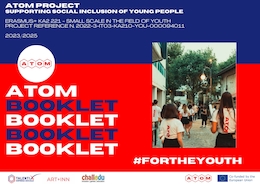Toolbox — For Training and Youth Work
All new tools in your inbox: Be the first to know about new tools for learning with our e-mail notifications.
Manual, Report
ATOM Booklet
The ATOM Booklet is the main deliverable of the ATOM project: an operational handbook, designed for trainers and youth workers, which gathers into a single tool everything needed to design and carry out non-formal learning pathways.
Aims of the tool
1. Define a framework of key competences
- Map and describe the social, intercultural and critical-thinking abilities needed to foster inclusion among young people.
- Provide operational indicators—knowledge, attitudes and behaviors—on which to design and evaluate non-formal learning pathways.
2. Illustrate the VIBES method step by step
- Explain the five phases (Explore – Learn – Share – Build – Give) with concrete activity examples.
- Offer practical tips for integrating storytelling, music and art as levers of engagement.
3. Offer a repertoire of non-formal exercises
- Present workshops, ice-breakers and laboratory sessions suited to mixed groups of young people, including those from disadvantaged backgrounds.
- Supply ready-to-use activity sheets that can be adapted to local contexts.
4. Equip trainers with evaluation tools
- Provide pre- and post-workshop questionnaires, observation rubrics and guidelines for gathering evidence of learning.
- Enable continuous monitoring of the impact on participants’ competences.
5. Guide context personalization
- Suggest criteria for tailoring activities to different age groups, specific needs and intercultural dynamics.
- Encourage trainers to co-design with young people, ensuring each pathway is genuinely inclusive.
6. Promote transnational sharing
- Harmonize terminology and approaches across Italy, Greece and Lithuania to facilitate the exchange of best practices.
- Lay the groundwork for future collaborations and exchanges among practitioners from different countries.
7. Strengthen youth workers’ professional development
- Offer a comprehensive tool for continuous professional development (CPD) and documentation of newly acquired competences.
- Contribute to raising recognition of the youth-worker role at the European level.
8. Ensure replicability and sustainability
- Create a user-friendly manual, translated into four languages, ready for download and printing.
- Provide guidelines for keeping the pathway active beyond the project’s end by fostering local facilitator communities.
Description of the tool
⛰️OVERVIEW
The ATOM Booklet is a comprehensive manual designed for youth workers, trainers, and educators engaged in inclusive youth work across Europe. Developed within the Erasmus+ framework, it offers a structured approach to fostering inclusion, participation, and empowerment among young people from diverse backgrounds.
It is available in 4 languages: English, Italian, Greek, Lithuanian.
Available downloads:
Disclaimer
SALTO cannot be held responsible for the inappropriate use of these training tools. Always adapt training tools to your aims, context, target group and to your own skills! These tools have been used in a variety of formats and situations. Please notify SALTO should you know about the origin of or copyright on this tool.
Tool overview

http://toolbox.salto-youth.net/5037
This tool is for
Youth workers and educators working with diverse or disadvantaged groups. Trainers and facilitators in Erasmus+ and European Solidarity Corps projects. NGO staff and community leaders promoting social inclusion and intercultural dialogue. Youth policy makers and project coordinators seeking practical tools for competence development. Students and young volunteers interested in inclusive facilitation and peer learning. Organizations aiming to build capacity for inclusive practices and transnational cooperation.
and addresses
Social Inclusion, Group Dynamics, Youth Initiatives, Intercultural Learning, Personal Development
It is recommended for use in:
Training and Networking
Capacity Building
Behind the tool
The tool was created by
TALENTIX, ART+INN, CHALLEDU
in the context of
ATOM Europe Erasmus Project (KA2)
The tool has been experimented in
Training
The tool was published to the Toolbox by
Daniele Riganello (on 27 July 2025)
and last modified
24 July 2025
Comments
No comments have been posted yet.
If you want to comment on this tool, you need to be signed in with your MySALTO account. Sign in now